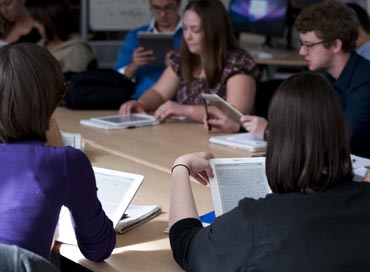Digital reading technology makes its way into UW-Madison classrooms
Alongside music, television and the news media, books are surging into the new technology era with digital reading devices.
UW-Madison Libraries were quick to get on board with the latest in electronic reading.

Undergraduate students refer to the Kindle DX, Amazon.com’s digital and wireless reading device, during a class discussion in Professor Jeremi Suri’s upper-level history seminar in H.C. White Hall on Oct. 5, 2009.
Photo: Jeff Miller
“The cost and convenience factor is really significant,” says UW–Madison Libraries director Ken Frazier. “There’s an enormous amount of content and book titles that are becoming available.”
Frazier says the library has been monitoring the wireless technology since it first emerged, but when Amazon introduced its new Kindle DX in May, Frazier knew it was time to take paperless reading into the classrooms.
History professors Jeremi Suri and William Cronon were enthusiastic about the technology and willing to bring it into their classrooms for a trial run to assess what place digital reading devices might have in the university’s future.
The UW–Madison Libraries purchased 20 Kindles last summer with $10,000 from the Parents Fund and distributed them to the 20 students in Suri’s upper-level history seminar “The Past and Future of Grand Strategy.”

Part of a pilot program for using new technology in the classroom, the 20 Kindles were purchased and distributed by UW–Madison Libraries with support from the Parents Enrichment Fund. The students will use the loaned device throughout the semester to read eight assigned texts, including the lengthy “War and Peace.”
Photo: Jeff Miller
The Kindles will be collected at the end of the semester and re-distributed in the spring to Cronon’s environmental history students.
The Kindle DX was particularly attractive to the UW–Madison Libraries because of its 9.7-inch screen and its ability to download PDF files, so professors can assign articles and digital excerpts from books without forcing students to print hundreds of pages or strain their eyes reading on their computers.
“I’m no fan of reading 60- to 75-page PDFs sitting stiffly in front of a computer,” says Sarah Mittermaier, one of Suri’s students. “Curling up in a comfy chair with a Kindle is painless.”
The Kindle DX, the largest available digital reading device, features a Vizplex screen, which was first developed at MIT. Rather than illuminating the screen like a computer, which can strain your eyes, the Vizplex screen combines several shades of gray to make each digital page appear similar to the paper page of a book.
“The Kindle itself is really light and pretty easy to read since the screen is more like an Etch A Sketch than a laptop,” says Jenna Hindi, another student in the class.
However, Frazier points out that there is still room for improvement. “I’m disappointed that the Kindle DX is not accessible to the blind,” he says.
Suri gave his 20 students the option of borrowing the Kindle or buying the paper copies of the eight required texts, including Leo Tolstoy’s 1,200-page “War and Peace.”
While some students opted to also buy some of the texts, all 20 of his students accepted the Kindle, recognizing its cost-saving and environmental benefits.
“Providing more access at a less-expensive, [less] ecologically damaging rate to students is the direction we need to be moving as we think about teaching,” Suri says.
Of the 17 students surveyed before the course, 14 said they typically spend $200 or more on their course books each semester. Four of them reported spending $500 or more.
While the Kindle DX costs nearly $500, that’s a one-time cost, and it usually costs less than $10 to upload a book, not to mention the thousands of cost-free uploads available in the public domain collection.
But Suri’s class, as will Cronon’s, gets access to the Kindle’s economical library free of cost. With the Kindles lent for no charge and the course texts already uploaded, students are free to download as much as they want and transfer their files onto their personal computers when the semester is over.
It’s only a few weeks into the semester and Suri already sees that introducing the Kindle into the classroom has enhanced the course.
“We read classical wisdom and classical thoughts from 2,500 years ago or more, and we think about how those ideas can be relevant and useful for the world we live in today,” he says. “Doing this on the Kindle makes us very conscious of the potential for using classical wisdom in a more technologically advanced environment.”
Although Suri and his students’ experience with the Kindle has been overwhelmingly positive, Frazier points out they’re always on the lookout for newer digital reading technology.
“We have no commitment to this device,” he says. “The future of this depends on what we learn. This is really about everybody learning and it seems very likely that we’re going to see better and cheaper electronic reading devices.”
But Frazier has no doubts that there will be a future in electronic reading.
“I think that this is a breakthrough technology now,” he says. “I don’t know what the tipping point will be, but I can’t imagine that it isn’t going to happen. There are just too many advantages.”

